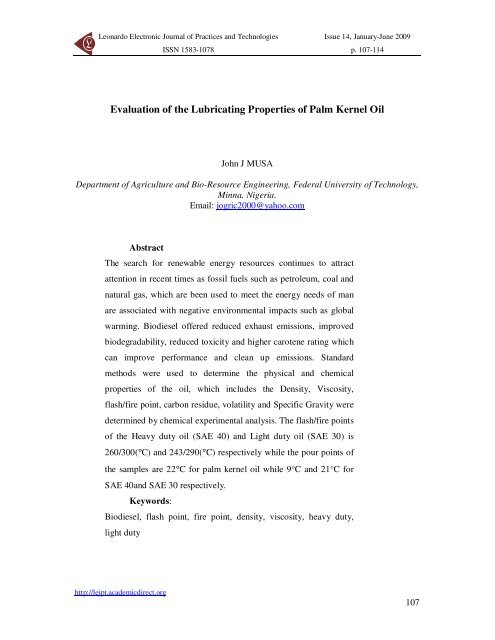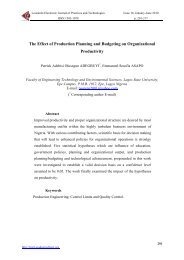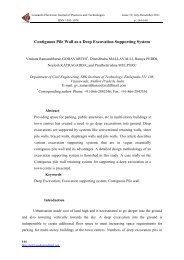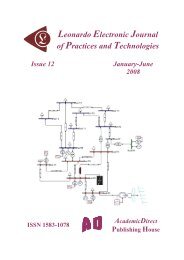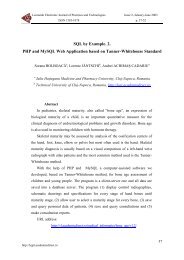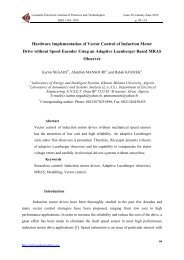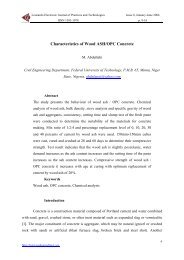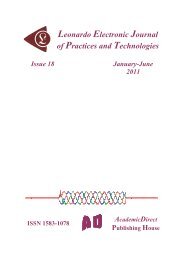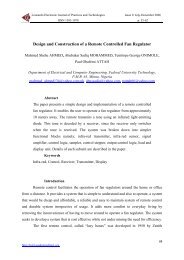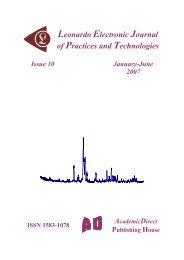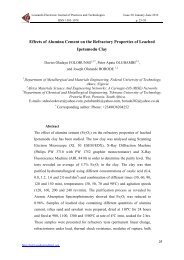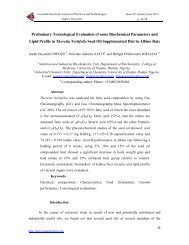Evaluation of the Lubricating Properties of Palm Kernel Oil
Evaluation of the Lubricating Properties of Palm Kernel Oil
Evaluation of the Lubricating Properties of Palm Kernel Oil
Create successful ePaper yourself
Turn your PDF publications into a flip-book with our unique Google optimized e-Paper software.
Leonardo Electronic Journal <strong>of</strong> Practices and Technologies<br />
http://lejpt.academicdirect.org<br />
ISSN 1583-1078<br />
Issue 14, January-June 2009<br />
p. 107-114<br />
<strong>Evaluation</strong> <strong>of</strong> <strong>the</strong> <strong>Lubricating</strong> <strong>Properties</strong> <strong>of</strong> <strong>Palm</strong> <strong>Kernel</strong> <strong>Oil</strong><br />
John J MUSA<br />
Department <strong>of</strong> Agriculture and Bio-Resource Engineering, Federal University <strong>of</strong> Technology,<br />
Minna. Nigeria.<br />
Email: jogric2000@yahoo.com<br />
Abstract<br />
The search for renewable energy resources continues to attract<br />
attention in recent times as fossil fuels such as petroleum, coal and<br />
natural gas, which are been used to meet <strong>the</strong> energy needs <strong>of</strong> man<br />
are associated with negative environmental impacts such as global<br />
warming. Biodiesel <strong>of</strong>fered reduced exhaust emissions, improved<br />
biodegradability, reduced toxicity and higher carotene rating which<br />
can improve performance and clean up emissions. Standard<br />
methods were used to determine <strong>the</strong> physical and chemical<br />
properties <strong>of</strong> <strong>the</strong> oil, which includes <strong>the</strong> Density, Viscosity,<br />
flash/fire point, carbon residue, volatility and Specific Gravity were<br />
determined by chemical experimental analysis. The flash/fire points<br />
<strong>of</strong> <strong>the</strong> Heavy duty oil (SAE 40) and Light duty oil (SAE 30) is<br />
260/300(°C) and 243/290(°C) respectively while <strong>the</strong> pour points <strong>of</strong><br />
<strong>the</strong> samples are 22°C for palm kernel oil while 9°C and 21°C for<br />
SAE 40and SAE 30 respectively.<br />
Keywords:<br />
Biodiesel, flash point, fire point, density, viscosity, heavy duty,<br />
light duty<br />
107
108<br />
<strong>Evaluation</strong> <strong>of</strong> <strong>the</strong> <strong>Lubricating</strong> <strong>Properties</strong> <strong>of</strong> <strong>Palm</strong> <strong>Kernel</strong> <strong>Oil</strong><br />
Introduction<br />
John J MUSA<br />
Modern bi<strong>of</strong>uels have been reported as a promising long term renewable energy<br />
source which has potential to address both environmental impacts and security concerns<br />
posed by current dependence on fossil fuels [4, 1, 5]. Fossil fuels such as petroleum, coal and<br />
natural gas, which have been used to meet <strong>the</strong> energy needs <strong>of</strong> man, are associated with<br />
negative environmental impacts such as global warming [10, 15]. Besides, supply <strong>of</strong> <strong>the</strong>se<br />
non-renewable energy sources is threatening to run out in a foreseeable future [14, 10]. It has<br />
been widely reported that not less than ten major oil fields from <strong>the</strong> 20 largest world oil<br />
producers are already experiencing decline in oil reserves.<br />
In comparison to petroleum-based fuels, biodiesel <strong>of</strong>fered reduced exhaust emissions,<br />
improved biodegradability, reduced toxicity and higher carotene rating which can improve<br />
performance and clean up emissions. Typical biodiesel produces about 65% less net carbon<br />
monoxide, 78% less carbon dioxide, 90% less sulphur dioxide and 50% less unburned<br />
hydrocarbon emission [8, 13, 6, 7].<br />
The search for renewable energy resources continues to attract attention in recent<br />
times. It has been reported that in diesel engines, vegetable oils can be used directly as fuel, or<br />
as blend with petroleum diesel [5, 9]. However, due to high viscosity <strong>of</strong> <strong>the</strong>se oils, poor fuel<br />
atomization occurs in CI engines resulting in improper fuel-air mixture and inefficient<br />
combustion [3, 15]. The problem also manifests in injector coking, engine deposits and<br />
thickening <strong>of</strong> lubricants during extended operation <strong>of</strong> <strong>the</strong> engine [13, 1].<br />
<strong>Oil</strong> palm is indigenous to <strong>the</strong> Nigerian coastal area. It was discovered by European<br />
explorers in <strong>the</strong> early 1400’s and was distributed throughout tropical Africa by humans who<br />
practiced shifting agriculture about 5000 years ago. The palm plant originated from <strong>the</strong> jungle<br />
forest <strong>of</strong> East Africa and about 5000 years ago, palm oil was used by <strong>the</strong> pharaohs for cooking<br />
and lighting. The cultivation <strong>of</strong> oil palm is restricted to <strong>the</strong> eastern sub zones where its growth<br />
is favoured environmentally and climatically. Besides, it is a major cash crop in this region.<br />
The first oil palm plantation was established at Sumatra in 1911 and at Malaysia in 1917.<br />
About this time it was simultaneously established in West Africa and tropical America.<br />
Over <strong>the</strong> years, a little attention was paid to <strong>the</strong> industrial use <strong>of</strong> palm kernel oil.<br />
Never<strong>the</strong>less, recent studies have indicated that apart from <strong>the</strong>ir domestic uses that <strong>the</strong>y can<br />
be used as engine lubricants, as replacement for biodiesel if <strong>the</strong>ir properties are enhanced.
Leonardo Electronic Journal <strong>of</strong> Practices and Technologies<br />
ISSN 1583-1078<br />
Issue 14, January-June 2009<br />
p. 107-114<br />
Although high in saturated fats, it is a different oil to extract from <strong>the</strong> nut or kernel <strong>of</strong><br />
palms which has a yellowish white colour and a pleasantly mild flavor similar to coconut oil<br />
in fatty oil acid composition and properties.<br />
<strong>Palm</strong> kernel oil (PKO) is gotten from <strong>the</strong> kernel <strong>of</strong> <strong>the</strong> palm fruit and it is located<br />
inside <strong>the</strong> hard shell while <strong>the</strong> outer fleshy mesocarp gives palm oil. The fatty acids mostly<br />
found in palm kernel oil are presented in Table 1 below.<br />
Source: [2]<br />
Table 1. Fatty acid pr<strong>of</strong>ile <strong>of</strong> PKO<br />
Type <strong>of</strong> fatty acid Percentage<br />
Lauric (C12:0) 48.2<br />
Myristic (C14:0) 16.2<br />
<strong>Palm</strong>itic (C16:0) 8.4<br />
Capric (C10:0) 3.4<br />
Caprylic (C8:0) 3.3<br />
Stearic (C18:0) 2.5<br />
Oleic (C18:1) 15.3<br />
Linoleic (C18:2) 2.3<br />
O<strong>the</strong>rs (unknown) 0.4<br />
<strong>Palm</strong> kernel oil (PKO) is more unsaturated and hence can be hydrogenated to a wider<br />
range <strong>of</strong> products which could be used ei<strong>the</strong>r alone or in blends with o<strong>the</strong>r oil for biscuit<br />
dough, filling creams, cake icing, ice cream, imitation whipping cream, substitute chocolate<br />
and o<strong>the</strong>r coatings, sharp melting and melting margarines etc. Lauric oil (CNO, PKO) is very<br />
important in soap making and a good soap must contain at least 15% lauric acids for quick<br />
la<strong>the</strong>ring while soap made for use in sea water is based on virtually100% lauric oils. Mostly<br />
palm kernel oil are now used for <strong>the</strong> manufacture <strong>of</strong> short chain fatty acids, fatty alcohols,<br />
methyl esters, fatty amines, for use in detergents, cosmetics and many o<strong>the</strong>r cosmetic products<br />
but less consideration is given it for o<strong>the</strong>r purpose [11].<br />
Lubrication is <strong>the</strong> process or technique employed in reducing wear or tear <strong>of</strong> one or<br />
both surfaces in close proximity and moving relative to each o<strong>the</strong>r by interposing a substance<br />
called lubricant between <strong>the</strong> surfaces to carry or help carry <strong>the</strong> load between <strong>the</strong> opposing<br />
surfaces [12]. It could be a solid e.g. graphite, liquid, solid-liquid dispersion or liquid–liquid<br />
dispersion e.g. grease. It also helps to reduce <strong>the</strong> friction generated between surfaces in<br />
contact, frictional forces tend to develop within <strong>the</strong> surfaces and this phenomenon can be <strong>of</strong><br />
adverse effect if not controlled. However, all <strong>of</strong> <strong>the</strong>se effects can be minimized if surfaces are<br />
109
110<br />
<strong>Evaluation</strong> <strong>of</strong> <strong>the</strong> <strong>Lubricating</strong> <strong>Properties</strong> <strong>of</strong> <strong>Palm</strong> <strong>Kernel</strong> <strong>Oil</strong><br />
John J MUSA<br />
kept constantly lubricated. Basically, <strong>the</strong> engine oil is <strong>the</strong> liquid used for <strong>the</strong> lubrication <strong>of</strong><br />
various internal combustion engines. They are mostly derived from petroleum products which<br />
consist <strong>of</strong> Hydrocarbons, in <strong>the</strong> combination <strong>of</strong> Hydrogen and Carbon elements. Wears and<br />
Tears are reduced by applying lubrication oil because it creates a separating film between<br />
surfaces <strong>of</strong> adjacent moving parts to minimize direct contact between <strong>the</strong>m and hence<br />
decrease friction, wear, production <strong>of</strong> excessive heat and thus protecting <strong>the</strong> engine.<br />
The main objectives <strong>of</strong> this study are to evaluate <strong>the</strong> lubricating properties <strong>of</strong> palm<br />
kernel oil and to compare <strong>the</strong>se characteristics to those <strong>of</strong> <strong>the</strong> normal engine oil.<br />
Materials and Methods<br />
The materials and equipment used in carrying out this research work include palm<br />
kernel oil samples, water, open viscometer cup, stopwatch, beakers(Graduated), retort stand,<br />
weighing equipment, camp magnetic stirrer regulator hot plate, cleave land open cup<br />
Apparatus, <strong>the</strong>rmometer, gas burner, viscometer bath, holding cylinder, heater, flask (flat<br />
bottom) and torch nozzle.<br />
Standard methods were used to determine <strong>the</strong> physical and chemical properties <strong>of</strong> <strong>the</strong><br />
oil, which includes <strong>the</strong> Density, Viscosity, flash/fire point, carbon residue, volatility and<br />
Specific Gravity were determined by chemical experimental analysis. Bleaching <strong>of</strong> <strong>the</strong><br />
samples and test for <strong>the</strong> above-mentioned properties were also carried out. Conventional<br />
sample lubricant was collected and similar tests were conducted to compare results obtained.<br />
Results<br />
The results obtained were based on <strong>the</strong> physical and chemical analysis carried out on<br />
<strong>the</strong> samples. The open cup method was adopted for <strong>the</strong> flash/fire points test due to its<br />
simplicity. Viscosity was determined with <strong>the</strong> aid <strong>of</strong> <strong>the</strong> viscometer. From <strong>the</strong> results<br />
obtained, it is seen that <strong>the</strong> flash points <strong>of</strong> palm kernel oil 242°C while <strong>the</strong> fire points are<br />
251°C. This property <strong>of</strong> lubricant shows <strong>the</strong>ir response to heat and flame under controlled<br />
conditions. Conversely <strong>the</strong> flash/fire points <strong>of</strong> <strong>the</strong> Heavy duty oil (SAE 40) and Light duty oil
Leonardo Electronic Journal <strong>of</strong> Practices and Technologies<br />
ISSN 1583-1078<br />
Issue 14, January-June 2009<br />
p. 107-114<br />
(SAE 30) is 260/300(°C) and 243/290(°C) respectively. Tables 2 presents <strong>the</strong> properties <strong>of</strong> <strong>the</strong><br />
various samples considered for both <strong>the</strong> physical and chemical properties.<br />
Sample<br />
<strong>Properties</strong><br />
<strong>Palm</strong><br />
<strong>Kernel</strong> oil<br />
Heavy duty<br />
oil (SAE<br />
40)<br />
Light duty<br />
oil (SAE<br />
30)<br />
Flash<br />
point(°C)<br />
Table 2. <strong>Properties</strong> <strong>of</strong> samples and <strong>the</strong>ir values<br />
Fire<br />
point(°C)<br />
Pour<br />
point(°C)<br />
Specific<br />
density(mg/ml)<br />
Viscosity<br />
at 40°(cst)<br />
242 251 22 0.886 115.55 8.10<br />
Viscosity<br />
at 100°C<br />
(cst)<br />
260 300 9 0.868 159.20 15.87<br />
243 290 21 0.895 104.00 12.00<br />
It is quite clear from <strong>the</strong> results obtained that palm kernel oil have very good flash/fire<br />
points as <strong>the</strong>y can be compared with those <strong>of</strong> <strong>the</strong> conventional lubricants like SAE 40 and<br />
SAE 30. The pour points <strong>of</strong> <strong>the</strong> samples are 22°C for palm kernel oil while 9°C and 21°C for<br />
SAE 40and SAE 30 respectively meaning that <strong>the</strong> flash point for PKO is close to that <strong>of</strong> <strong>the</strong><br />
light duty oil <strong>of</strong> SAE 30 though <strong>the</strong> firing point <strong>of</strong> PKO is far lower when compared with<br />
those <strong>of</strong> <strong>the</strong> SAE 30 and 40. The implication <strong>of</strong> this is that PKO could be used both in humid<br />
and temperate regions. Since <strong>the</strong> pour point is <strong>the</strong> minimum temperature <strong>of</strong> a liquid,<br />
particularly a lubricant after which on decreasing <strong>the</strong> temperature, <strong>the</strong> samples cease to flow.<br />
Consequently, it will be correct to say that <strong>the</strong> samples under consideration have pour points<br />
that satisfy <strong>the</strong>ir use as engine lubricating oils.<br />
The densities <strong>of</strong> <strong>the</strong> samples were also determined to ascertain <strong>the</strong> compatibility <strong>of</strong><br />
PKO with ei<strong>the</strong>r <strong>the</strong> heavy or light duty engines which is <strong>the</strong> ability <strong>of</strong> <strong>the</strong> samples to mix<br />
with o<strong>the</strong>r liquids. The results showed palm kernel oil (PKO), Heavy duty (SAE 40) and<br />
Light duty (SAE 30) have densities <strong>of</strong> 0.886, 0.868, and 0.895(mg/ml) respectively. The<br />
results indicate that palm kernel oil has good values <strong>of</strong> specific gravity and will help in case <strong>of</strong><br />
contamination with water which will settle below <strong>the</strong> oil and can be drain <strong>of</strong>f.<br />
Consequently, <strong>the</strong> viscosity <strong>of</strong> <strong>the</strong> samples was also determined, when <strong>the</strong> operating<br />
temperatures <strong>of</strong> <strong>the</strong> engine was 40°C and 100°C respectively. It is seen from <strong>the</strong> results in<br />
Table 2 that PKO at 40°C and 100 0 C have viscosities <strong>of</strong> 115.55 and 8.10(centistokes)<br />
respectively. This indicates a decrease <strong>of</strong> 93% which when compared with <strong>the</strong> conventional<br />
111
112<br />
<strong>Evaluation</strong> <strong>of</strong> <strong>the</strong> <strong>Lubricating</strong> <strong>Properties</strong> <strong>of</strong> <strong>Palm</strong> <strong>Kernel</strong> <strong>Oil</strong><br />
John J MUSA<br />
lubricants showed a decrease <strong>of</strong> about 90% and 88% for <strong>the</strong> heavy duty (SAE 40) and light<br />
duty (SAE 30) respectively. This percentage decrease in viscosity shows that as <strong>the</strong><br />
temperature is increased from 40°C to 100°C <strong>the</strong> viscosity <strong>of</strong> <strong>the</strong> light duty reduces by 88%,<br />
while that <strong>of</strong> <strong>the</strong> heavy duty reduces by 90%. Since viscosity is <strong>the</strong> most important parameter<br />
in terms <strong>of</strong> lubricating oil, <strong>the</strong>ir individual strength is reflected in <strong>the</strong> percentage decrease in<br />
viscosity on increasing <strong>the</strong>ir temperatures from 40°C to 100°C.<br />
Although <strong>the</strong> percentage decrease is high in PKO it can be enhanced by adding certain<br />
additives such as Thiadiazole dimmer (DMS2) and Polyglycol (DMS2-GL) by syn<strong>the</strong>sizing<br />
<strong>the</strong>m as ashless grease additives or bleaching <strong>the</strong> samples to help improve on <strong>the</strong>ir lubricating<br />
qualities.<br />
Conclusions<br />
Based on <strong>the</strong> results obtained from <strong>the</strong> various tests carried out on <strong>the</strong> lubricating<br />
properties <strong>of</strong> palm kernel oil, <strong>the</strong> following conclusions can were drawn;<br />
• It was observed that <strong>the</strong> flash/fire points <strong>of</strong> <strong>the</strong> palm oil and palm kernel oil and <strong>the</strong><br />
bleached sample meet <strong>the</strong> required SAE specifications. The values obtained were 242°C<br />
for palm kernel oil. This value is in line with those obtained from both Heavy duty oil<br />
(SAE 40) and Light duty oil (SAE 30) with flash/fire points <strong>of</strong> 260°C/300°C and<br />
243°C/290°C respectively.<br />
• The pour point <strong>of</strong> 22°C for PKO when compared with that <strong>of</strong> Light duty (SAE 30) which<br />
had a pour point <strong>of</strong> 21°C is more preferred. While that <strong>of</strong> heavy duty oil (SAE 40) is 9°C.<br />
The reason for <strong>the</strong> low pour point value obtained from heavy duty is owned to <strong>the</strong> fact that<br />
it has a higher viscosity compared to <strong>the</strong> o<strong>the</strong>r samples. In essence, <strong>the</strong> higher <strong>the</strong><br />
viscosity <strong>of</strong> a sample <strong>the</strong> lower its pour point and vice versa. This statement is evident<br />
from <strong>the</strong> results obtained from <strong>the</strong> tests conducted on <strong>the</strong> samples.<br />
• The specific density <strong>of</strong> 0.882mg/ml, 0.886mg/ml and 0.899 for palm oil, palm kernel oil<br />
and <strong>the</strong> bleached palm oil respectively conforms to those <strong>of</strong> Heavy duty (SAE 40) and<br />
Light duty (SAE 30) with values <strong>of</strong> 0.868mg/ml and 0.895mg/ml respectively. It is<br />
obvious that palm kernel oil (PKO) has good value <strong>of</strong> density. Hence it will help in case<br />
<strong>of</strong> contamination with water which will settle below <strong>the</strong> oil and will subsequently be
Leonardo Electronic Journal <strong>of</strong> Practices and Technologies<br />
drained <strong>of</strong>f.<br />
ISSN 1583-1078<br />
Issue 14, January-June 2009<br />
p. 107-114<br />
• It was also observed that <strong>the</strong> viscosity <strong>of</strong> <strong>the</strong> samples decreased with increase in<br />
temperature. This was best with <strong>the</strong> Light duty which decreased from 104cst to 12cst<br />
while PKO had a viscosity <strong>of</strong> 115.55mg/ml at 40°C and 8.1mg/ml at 100°C and <strong>the</strong> heavy<br />
duty (SAE 40) had a viscosity <strong>of</strong> 159.20mg/ml at 40°C and 15.87mg/ml at 100°C. On<br />
increasing <strong>the</strong> operating temperatures from 40°C to 100°C, <strong>the</strong> samples analyzed showed<br />
various percentage decrease in <strong>the</strong>ir viscosities. PKO showed a decrease <strong>of</strong> 93% on<br />
increasing <strong>the</strong>ir operating temperatures.<br />
• It was also observed that <strong>the</strong> shear strength <strong>of</strong> <strong>the</strong> various samples varies depending on<br />
<strong>the</strong>ir various carotene contents. On increasing <strong>the</strong> temperature from 40 o C to 100 o C <strong>the</strong><br />
sampled, each showed various percentage decrease in <strong>the</strong>ir shear strength which is<br />
indicated in <strong>the</strong>ir viscosities.<br />
References<br />
1. Alamu, O. J.; Waheed, M. A.and Jekayinfa, S. O.: Biodiesel production from Nigerian<br />
palm kernel oil: effect <strong>of</strong> KOH concentration on yield, Energy forSustainable<br />
Development. 11(3): 77-82, 2007.<br />
2. Alamu, O. J.; Akintola, T. A.; Enweremadu, C. C. and Adeleke, E. O. Characterization <strong>of</strong><br />
palm kernel oil biodiesel produced through NaOH- catalysed transerterification process.<br />
Scientific Research and Essay Vol. 3 (7) 308-311, 2008.<br />
3. Bari S, Yu CW, Lim TH Performance deterioration and durability issues whilerunning a<br />
diesel engine with crude palm oil, Proc. I Mech E Part D, J. Automobile Eng. 216: 785-<br />
792, 2002.<br />
4. Batidzirai B, Faaij APC, Smeets E Biomass and bioenergy supply fromMozambique,<br />
Energy for Sustainable Development, 10(1): 54-81, 2006.<br />
5. Gupta PK, Kumar R, Panesar BS, Thapar VK Parametric studies on bio-diesel prepared<br />
from rice bran oil. Agricultural Engineering International: <strong>the</strong> CIGR J. Sci. Res. Dev.<br />
9(EE 06-007), 2007.<br />
113
114<br />
<strong>Evaluation</strong> <strong>of</strong> <strong>the</strong> <strong>Lubricating</strong> <strong>Properties</strong> <strong>of</strong> <strong>Palm</strong> <strong>Kernel</strong> <strong>Oil</strong><br />
John J MUSA<br />
6. Kno<strong>the</strong> G, Steidley KS Kinematic viscosity <strong>of</strong> biodiesel fuel component andrelated<br />
compounds: Influence <strong>of</strong> compound structure and comparison to petrodiesel fuel<br />
components, Fuel, 1059–1065, 2005.<br />
7. Krahl J, Munack A, Schröder O, Stein H, Herbst L, Kaufmann A, Bünger J Fuel design as<br />
constructional element with <strong>the</strong> example <strong>of</strong> biogenic and fossil diesel fuels, Agricultural<br />
Engineering International: <strong>the</strong> CIGR J. Sci. Res. Dev. 7(EE 04 008), 2005.<br />
8. Margaroni D Fuel lubricity, Industrial Lubrication and Tribology. 50(3): 108-118, 1998.<br />
9. Math MC Performance <strong>of</strong> a diesel engine with blends <strong>of</strong> restaurant waste oil methyl ester<br />
and diesel fuel, Energy for Sustainable Development, 11(3): 93-95, 2007.<br />
10. Munack, A.; Schroder, O.; Krahl, J. and Bunger, J.: Comparison <strong>of</strong> relevant exhaust gas<br />
emissions from biodiesel and fossil diesel fuel Agricultural Engineering International: <strong>the</strong><br />
CIGR J. Sci. Res. Dev. 3(EE 01- 001), 2001.<br />
11. Pantzaris T.P and Mohammed J. A.: <strong>Palm</strong> <strong>Kernel</strong> oil article. <strong>Palm</strong> <strong>Oil</strong> ResearchInstitute <strong>of</strong><br />
Malaysia (PORIM), 2000.<br />
12. Parsons, G. M. :Biodiesel and Engine Lubrication; Part 2. Chevron Products Company<br />
Publishers, San Ramon, Califonia. Pp 1 -16, 2007.<br />
13. Ryan TW, Callahan TJ, Dodge LG: Characterization <strong>of</strong> vegetable oils for use as fuel in<br />
diesel engines, Proc. International Conf. on Plaint <strong>Oil</strong>s as Fuels. American Society <strong>of</strong><br />
Agricultural Engineers 4(82): 70-81, 1982.<br />
14. Sambo AS Renewable energy technology in Nigeria: resource availability and potential<br />
for application to agriculture. J. Agric. Technol., 3(1): 1-4, 1981.<br />
15. Saravanan S, Nagarajan G, Rao GLN, Sampath S Feasibility study <strong>of</strong> crude rice bran oil<br />
as a diesel substitute in a DI-CI engine without modifications, Energy for Sustainable<br />
Development, 11(3): 83- 95, 2007.


